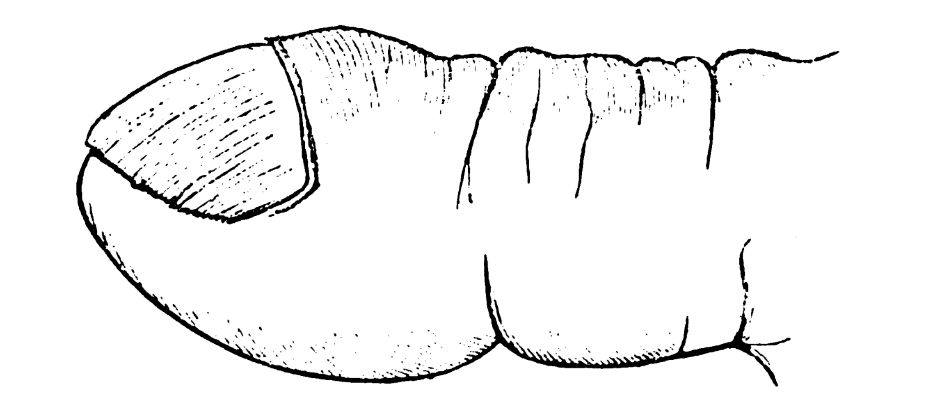Bamberger–Marie syndrome
Piere Marie-Bamberger syndrome or hypertrophic osteoarthropathy (HOA), is a rare clinical entity characterized by digital clubbing, periostosis of long bones, and synovial effusions. It exists in two forms: primary HOA, a hereditary and less common form (also termed pachydermoperiostosis), and secondary HOA, which arises in association with systemic conditions — most notably intrathoracic malignancies such as non-small cell lung carcinoma.
The condition is primarily paraneoplastic in adults, where its presence may precede the detection of a pulmonary neoplasm. HOA is more common in adult males, particularly those with underlying lung disease.
Diagnosis is primarily clinical and radiographic, with bone scintigraphy sometimes used. Elevated prostaglandin E₂ and VEGF levels are implicated in pathogenesis. Management focuses on treating the underlying cause; resection of associated tumours often leads to symptom regression. Supportive measures include NSAIDs for pain relief.
First formally delineated in 1889-1891 by Eugen von Bamberger (1858–1921) and Pierre Marie (1853–1940), the syndrome gained traction in medical literature as a distinctive clinicopathological entity. Its recognition remains important in identifying hidden malignancy.
History of Bamberger–Marie syndrome
~400 BCE – Hippocrates describes clubbing as “drumstick fingers” in his treatise on empyema as a sign of severe lung disease and is regarded as one of the earliest clinical signs in medicine.
1889 – Eugen von Bamberger (1858–1921) presents to the Vienna Medical Society his observations of digital clubbing in non-tuberculous bronchiectasis, published in Wiener klinische Wochenschrift
1890 – Pierre Marie (1853–1940) publishes a seminal 36-page monograph describing what he terms l’ostéo-arthropathie hypertrophiante pneumique, citing Bamberger’s observations as a precedent.
…c’est un fait d’observation vulgaire que dans la tuberculose les doigts subissent fréquemment la déformation en baguettes de tambour. De même tout récemment (Société des Médecins de Vienne, séance du 8 mars 1889), le professeur Bamberger disait avoir observé dans plusieurs cas les doigts hippocratiques chez des individus atteints uniquement de dilatation des bronches sans tuberculose. Or ce que je soutiens c’est que la déformation qui fait l’objet du présent travail est, soit au point de vue morphologique, soit au point de vue pathogénique, un phénomène du même ordre que les doigts hippocratiques
…it is a common observation that in tuberculosis, the fingers frequently undergo the drumstick deformation. Similarly, very recently (Vienna Medical Society, meeting of March 8, 1889), Professor Bamberger reported having observed Hippocratic fingers in several cases in individuals suffering only from bronchial dilation without tuberculosis. The deformity is from a morphological or pathogenic point of view, a phenomenon of the same order as hippocratic fingers.
Marie cites Nikolaus Friedreich (1825-1882) and his 1868 paper – Hyperostose des gesamten Skelettes) in brothers Karl and Wilhelm Hagner in the context of bone and joint pathology described as potentially acromegalic.

Marie differentiates the periosteal changes seen in hypertrophic osteoarthropathy from those of acromegaly, highlighting:
- In HOA, periostosis occurs primarily at the diaphyses and metaphyses of long bones.
- Joint effusions are common, but soft-tissue overgrowth and jaw enlargement, the hallmarks of acromegaly, are absent.
- The HOA processes are symmetrical and closely tied to pulmonary disease, rather than the endocrine-driven bone expansion seen in acromegaly.
This sharp clinical distinction demonstrates Marie’s careful morphological and pathogenetic classification, years before modern endocrinology could confirm hormonal causes.
1891 – Bamberger expands on his findings in chronic heart and lung disease with Über Knochenveränderungen bei chronischen Lungen- und Herzkrankheiten.
20th century – The syndrome is increasingly linked to thoracic malignancies (notably NSCLC), right-to-left cardiac shunts, and hepatic disease.
1990s–2000s – Discovery of elevated prostaglandin E2 and COX-2 overexpression in affected patients. Surgical resection of associated tumours often leads to regression of symptoms.
2023 – Koliakos et al. describe a classic presentation of Bamberger-Marie syndrome leading to the diagnosis of a 9 cm pulmonary adenocarcinoma. Post-surgical remission of HOA symptoms is observed, affirming its paraneoplastic nature.
Associated Persons
- Nikolaus Friedreich (1825-1882) – Provided early histological descriptions in 1868.
- Eugen von Bamberger (1858–1921) – Austrian internist; the first to link clubbing and periostosis with bronchiectasis.
- Pierre Marie (1853–1940) – French neurologist; first to define the triad of clubbing, periostosis, and joint swelling—coining the term ostearthropathie hypertrophiante pneumique.
- Karl and Wilhelm Hagner – Brothers in whose cases Marie saw early descriptions of skeletal changes akin to HOA.
Alternative names
- Piere Marie-Bamberger syndrome
- Hypertrophic osteoarthropathy (HOA)
References
Historical references
- Friedreich N. Hyperostose des gesamten Skelettes. Archiv für pathologische Anatomy und Physiologie und fürlinische Medicin, 1868; 43(1): 83-87
- Bamberger E. Veränderungen der Röhrenknochen bei Bronchiektasie. Wiener klinische Wochenschrift. 1889;2:226.
- Marie P. De l’ostéo-arthropathie hypertrophiante pneumique. Revue de médecine 1890; 10: 1-36
- Bamberger E. Über Knochenveränderungen bei chronischen Lungen- und Herzkrankheiten. Zeitschrift für klinische Medizin. 1891;18:193–217.
Eponymous term review
- Düster P. Pierre-Marie-Bamberger Syndrom – Ein paraneoplastisches Syndrom beim Bronchialkarzinom – Ein Fallbericht – [Pierre-Marie-Bamberger syndrome – a paraneoplastic syndrome of lung cancer – a case report]. Zentralbl Chir. 2002 Jan;127(1):59-61
- Koliakos E, Chappalley D, Kalogiannis E, Sgardello S, Christodoulou M. Pierre-Marie Bamberger Syndrome Leading to the Diagnosis and Surgical Treatment of a Localized Lung Cancer. Cureus. 2023 Nov 18;15(11):e48991.
eponymictionary
the names behind the name
BA MA (Oxon) MBChB (Edin) FACEM FFSEM. Emergency physician, Sir Charles Gairdner Hospital. Passion for rugby; medical history; medical education; and asynchronous learning #FOAMed evangelist. Co-founder and CTO of Life in the Fast lane | On Call: Principles and Protocol 4e| Eponyms | Books |
